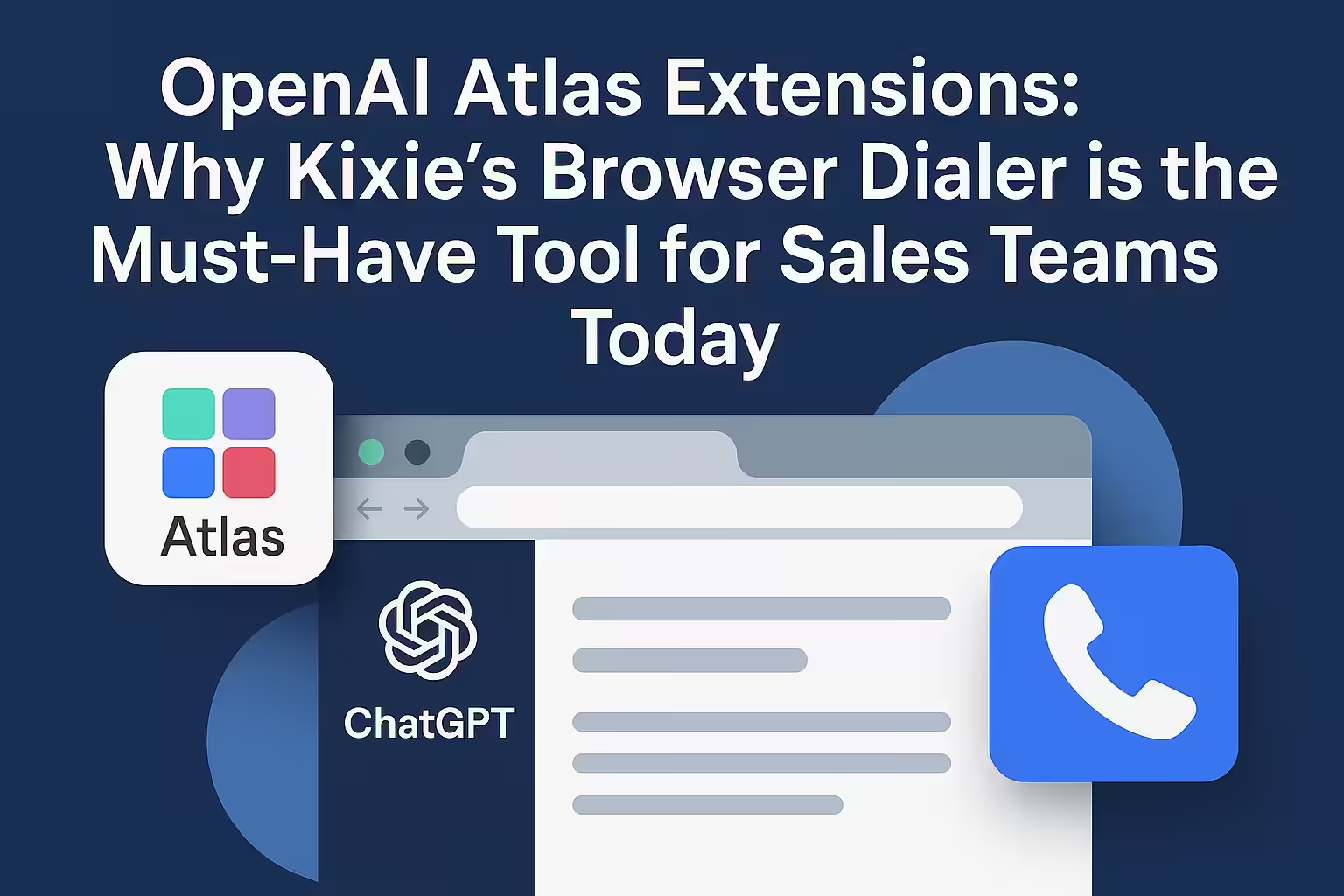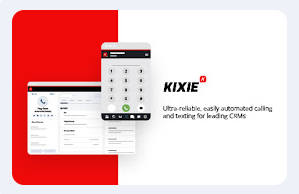What is OpenAI Atlas? It's a new browser with ChatGPT built into its core. What does it do? It acts as an AI assistant that can "see" your active tab, find old research with "Smart Memory," and automate prospecting with "Agent Mode." The big question: Does Kixie work with Atlas? Yes, perfectly. How? Atlas is built on Chromium (the same base as Chrome), so the Kixie PowerCall extension you already use installs and works instantly. What's the workflow? Simple. Atlas is your research assistant; Kixie is your action tool. Let Atlas find 50 prospects, then use Kixie's PowerDialer to call them, log the activity to your CRM, and get to the human conversation faster.
A Sales Leader's Guide to OpenAI Atlas
For decades, the web browser has been the central, if often chaotic, workspace for sales professionals. The web browser workspace is a landscape of endless tabs, constant context-switching between CRM, LinkedIn, company websites, and email, and a significant amount of manual, repetitive research. While browsers have become faster, these browsers haven't fundamentally changed their role as passive windows to information. OpenAI's launch of the Atlas browser signals a paradigm shift. Marketed as a direct challenger to Google Chrome's long-standing dominance, the Atlas browser reimagines the browser not as a simple information retrieval tool, but as an active, intelligent partner in productivity. Built from the ground up with artificial intelligence at its core, the Atlas browser aims to transform how users find information, search, and work on the web. Unlike competitors where AI features are often bolted on as an afterthought, the Atlas browser places ChatGPT at the very center of the user experience. For sales leaders and their teams, the introduction of OpenAI's Atlas browser represents more than just a new piece of software; this new browser is a fundamental change in the nature of their digital workspace, turning it from a library of static data into a dynamic, conversational environment. Understanding the core capabilities of the Atlas browser is the first step toward using its potential to drive revenue.
Core Capability 1: The Integrated AI Assistant
The most immediate and impactful feature of the OpenAI Atlas browser is its integrated AI assistant. A persistent ChatGPT sidebar can be activated on any webpage, giving users a constant conversational partner that understands the context of what they are viewing. This assistant can "see" the content on the page, allowing the assistant to provide summaries, analyze data, compare products, or answer questions without the user ever needing to copy-paste information or switch to a different tab. For a sales professional, the applications of this integrated AI assistant are immediate and profound. Imagine a Business Development Representative (BDR) landing on a competitor's complex pricing page. Instead of spending 20 minutes deciphering tiers and features, the BDR can simply ask the Atlas sidebar: "Summarize the key differences between their Enterprise and Pro plans and create a battle card of our advantages." Or, when viewing a prospect's LinkedIn profile, a rep could ask the Atlas sidebar, "Based on this person's posts and job history, what are three potential pain points I can address in my outreach?" The AI assistant in the Atlas browser effectively automates the initial layer of cognitive processing, freeing up the sales rep to focus on strategy and personalization.
Core Capability 2: The "Smart Memory" System
The OpenAI Atlas browser introduces a powerful "Smart Memory" system designed to provide more personalized and context-aware assistance over time. The Atlas browser has a built-in memory that draws on past conversations and browsing history to inform its responses. An optional but powerful feature called "Browser Memories" allows ChatGPT to remember key details, facts, and insights from sites the user has visited, recalling that context when needed in the future. This "Smart Memory" system transforms the browser from a tool with amnesia into a partner with a memory. A sales rep researching a new vertical might visit dozens of websites over a week. With traditional browsers, that research is scattered across bookmarks, open tabs, or hastily written notes. With the Atlas browser, the rep can use natural language commands to use this browsing history. A command like, "Re-open the case studies I was looking at for the logistics company last week," or "Show me the Halloween decorations I looked at," instantly retrieves relevant pages, turning fragmented research into an organized asset. The "Smart Memory" system might remember a user's travel preferences or that they use a specific calendar application to shape its suggestions and assistance. This level of data collection by the "Smart Memory" system naturally raises questions about privacy. OpenAI has emphasized user control, making "Browser Memories" an opt-in feature and ensuring that this content is not used to train its models unless a user explicitly consents. Users have granular control, with the ability to view, archive, or delete all stored memories and use a toggle in the address bar to prevent the Atlas browser from viewing specific sensitive sites.
Core Capability 3: The Game-Changer - "Agent Mode"
While the integrated assistant and smart memory enhance productivity, the most revolutionary feature of the OpenAI Atlas browser for sales teams is "Agent Mode." "Agent Mode" is an enhanced capability that allows ChatGPT to move beyond conversation and take autonomous actions directly within the browser to complete multi-step tasks on the user's behalf. Available for premium subscribers (Plus, Pro, and Business users), "Agent Mode" is designed to handle complex workflows from start to finish. The potential for "Agent Mode" to automate high-effort, low-yield sales tasks is immense. Consider these sales-oriented commands that "Agent Mode" is designed to handle: Automated Prospecting: A BDR could instruct the agent, "Find the top 20 manufacturing companies in the Midwest with over 500 employees, identify their VPs of Operations on LinkedIn, and compile their names, companies, and profile URLs into a list." Competitive Intelligence: An Account Executive preparing for a key demo could command, "Review our team's shared documents on Google Drive about Project Titan, conduct competitive research on their top three rivals by analyzing their latest press releases and product pages, and compile the key differentiators into a brief." Data Aggregation: A sales manager could ask, "Analyze the sales data from the last quarter and summarize the performance of the East Coast team." "Agent Mode" represents a fundamental shift in the relationship between a user and their browser. The browser is no longer just a passive tool for executing commands; the Atlas browser becomes a delegate, an assistant capable of understanding intent and executing complex sequences of actions. This capability positions the browser not as a simple tool, but as an entry-level research assistant or BDR. For high-performing sales teams, this suggests a future where the most effective reps are not necessarily the best manual researchers, but the most skilled at delegating to and directing their AI agents.
Does Kixie Work with OpenAI's Atlas Browser?
With the arrival of a platform as potentially disruptive as the OpenAI Atlas browser, the first and most critical question for any high-velocity sales team is one of compatibility: Will our existing, mission-critical tools work in this new environment? For the thousands of revenue teams who rely on Kixie's PowerCall extension to drive their daily outreach, the question is pointed: Does Kixie, the industry's leading browser dialer, function within the Atlas browser? The short answer is an unequivocal and resounding yes. Kixie PowerCall integrates perfectly with the OpenAI Atlas browser. Kixie's seamless compatibility with Atlas is not an accident or a workaround; this compatibility is a direct result of a strategic technical decision by OpenAI that ensures the entire ecosystem of essential business tools can operate natively within its new AI-powered environment.
Why Kixie Works with Atlas
During its launch event, OpenAI focused on the revolutionary AI features of the Atlas browser. However, a crucial technical detail, found on the company's support pages, is the key to understanding its compatibility: the Atlas browser is built on Chromium. Chromium is the same open-source browser project developed and maintained by Google that serves as the foundation for Google Chrome, Microsoft Edge, Brave, and dozens of other browsers. This single fact—that Atlas is built on Chromium—is the linchpin of compatibility for the entire professional software ecosystem. By building on Chromium, OpenAI has ensured that the Atlas browser natively supports the vast library of standard Chrome extensions available on the Chrome Web Store. This was a deliberate and strategic choice. Using Chromium-based architecture drastically lowers the barrier to adoption for new users, as they don't have to abandon their essential tools. This choice also allows OpenAI to focus its engineering resources on its core competency—building world-class AI models and experiences—rather than reinventing the fundamental plumbing of a web browser. OpenAI's decision to use Chromium indicates that OpenAI's strategy is not to build a closed, proprietary ecosystem, but rather to become the default intelligence layer on top of the existing open web infrastructure. For Kixie users, this foundation on Chromium is a powerful validation that our browser-based platform is inherently future-proof.
Seamless Installation and Integration of Atlas and Kixie
The theoretical compatibility between Kixie and Atlas, promised by a Chromium foundation, is already a proven reality. Early adopters of the Atlas browser have confirmed their ability to install and run their favorite Chrome extensions without issue. For sales teams, this means integrating Kixie's powerful sales engagement engine into the new AI browser is as simple and straightforward as it is in Google Chrome. The Kixie installation process takes less than three minutes and requires just three simple steps:
Click the "Add to Chrome" button (which will function as "Add to Atlas") and log in with your Kixie credentials once the extension is installed. To further streamline the transition, the Atlas browser includes built-in tools to import all existing bookmarks, saved passwords, and browsing history from Chrome, Safari, or Firefox. This allows a sales team to migrate their entire workflow into the new AI-powered environment with virtually zero friction, picking up right where they left off but with a powerful new suite of AI capabilities at their disposal. This ease of integration redefines the term "OpenAI Atlas extensions" for a sales audience. While the Atlas browser technically supports any Chrome extension, the most powerful extension is not a simple utility but a complete platform capability. Kixie isn't just a button that works in the browser; Kixie is the definitive sales engagement platform for Atlas.
Layering Kixie's Sales Engine on Atlas's AI Brain
Confirming compatibility is only the first step. The true value lies not in the fact that Kixie and Atlas can work together, but in how Kixie and Atlas combine to create a workflow that is exponentially more powerful than the sum of its parts. This combination stems from a clear division of labor: the Atlas browser is a phenomenal, generalist AI research assistant, while Kixie is a highly specialized, AI-powered sales engagement engine. The Atlas browser can find prospects, summarize their business needs, and identify key decision-makers with incredible efficiency. However, the Atlas browser's capabilities stop there. The Atlas browser cannot dial a list of 50 prospects with a local presence number to boost connection rates. The Atlas browser cannot drop a pre-recorded voicemail with a single click. The Atlas browser cannot automatically log the outcome of a call, the recording, and detailed notes into a HubSpot or Salesforce record. This gap between insight and action is the critical "last mile" problem of AI in sales. Kixie's PowerCall extension, a powerful browser dialer, is the essential "action layer" that bridges this gap. The Kixie extension overlays sales-specific functionality onto the generalist AI environment of the Atlas browser. With features like one-click calling and texting from any webpage, deep, bi-directional CRM integration, and its own suite of AI-driven tools like a multi-line PowerDialer and local presence dialing, Kixie transforms the passive research generated by the Atlas browser into active, revenue-driving conversations.
Transforming AI Insights into Revenue
The combination of the OpenAI Atlas browser and the Kixie dialer creates an end-to-end, AI-assisted workflow that was previously impossible. The Atlas and Kixie combination seamlessly connects automated intelligence with human connection, solving the "last mile" problem and creating a dual-automation environment where both the digital workspace and the outreach tasks are optimized. The following table illustrates how this powerful Atlas and Kixie combination works in practice to produce strategic sales outcomes.
| OpenAI Atlas AI Capability | Kixie PowerCall Enhancement (The Browser Dialer) | Combined Strategic Sales Outcome |
|---|---|---|
|
"Agent Mode Prospecting: Atlas generates a list of 50 target contacts based on a complex prompt like, ""Find VPs of Logistics at e-commerce companies in the Southeast US."" 1"
|
Kixie's browser dialer automatically detects every phone number on the AI-generated page and adds a one-click call/text icon next to each one.9 The rep can then load this list into Kixie's multi-line PowerDialer to call up to 10 leads at a time.14
|
"Hyper-Efficient Speed-to-Lead: The workflow from AI-driven prospecting to initiating live conversations is reduced from hours of manual data entry and dialing to mere seconds. This directly impacts conversion rates, as Kixie customers have demonstrated by reducing time-to-first-call and boosting conversions.17"
|
|
"""Browser Memories"" Recall: A rep uses a natural language command in Atlas, ""Show me the tech company I researched on Tuesday,"" and Atlas instantly pulls up the prospect's company page.1"
|
The moment the page loads, the Kixie PowerCall dialer instantly displays the full HubSpot or Salesforce contact record associated with that company, including past activities, current deal stage, and notes, directly in the browser.19
|
"Deeply Contextual Outreach: The rep is armed not just with the webpage but with the entire relationship history from their CRM. This eliminates the need to switch tabs to the CRM and enables a hyper-personalized, timely follow-up call with a single click, turning a cold follow-up into a warm, informed conversation."
|
|
AI Sidebar Content Summary: A rep asks the Atlas sidebar to summarize a long press release about a prospect's new funding round. The summary highlights a key quote from the company's CFO.1
|
The rep highlights the CFO's name and phone number within the AI-generated summary. Kixie's click-to-call icon appears instantly. The rep makes an immediate call, and Kixie automatically logs the call activity, recording, and outcome to the CFO's CRM record.13
|
"Seamless Insight-to-Action Workflow: This closes the loop between passive research and active engagement. The AI provides the ""why"" to call (the funding news), and Kixie provides the ""how"" (the one-click, auto-logged call), turning an intelligence tool into a revenue-generating one without ever leaving the browser."
|
|
"Natural Language Tab Management: A rep, overwhelmed with research tabs, tells Atlas, ""Clean up my tabs and organize them by account name"".1"
|
"This complements Kixie's workflow perfectly. The rep can now go to the neatly organized tab group for ""Account A,"" see the list of contacts, and use Kixie's PowerDialer to efficiently work through that specific list before moving to the next organized tab group.16"
|
"Dual-Automation Environment: This creates a powerful combination where the AI assistant manages the digital workspace (macro-level organization), while the specialized sales dialer automates the core outreach tasks within that workspace (micro-level execution), maximizing focus and efficiency."
|
While the "Browser Memories" feature in Atlas is a powerful tool for individual productivity, those memories are private to the user's account and do not contribute to the collective knowledge of the sales team. Kixie's deep, bi-directional CRM integration ensures that every valuable interaction initiated from within the Atlas browser is captured, logged, and made available to the entire revenue organization. This reinforces the CRM's critical role as the central nervous system and single source of truth for the business—a function that a personalized AI browser is not designed to replace. In this new workflow, Kixie acts as the disciplined, automated data-entry agent that ensures individual productivity gains translate into institutional knowledge.
Building the Future-Proof Sales Stack
The launch of the OpenAI Atlas browser is more than the arrival of a new product; the Atlas launch is a clear signal about the future of business technology. The time of searching for a single, monolithic "do-it-all" platform that excels at every function is drawing to a close. The future-proof sales stack is not a single tool, but a modular setup built on a powerful, generalist AI foundation augmented by best-in-class, specialized applications that solve specific, high-stakes business problems.
Layering Specialists on Generalists
The winning model for the next decade of sales technology will be this layered approach of specialists on generalists. At the base layer, a generalist AI platform like OpenAI's Atlas browser will handle broad information processing, research, content creation, and task automation. On top of this AI foundation, revenue teams will layer specialized, vertical-specific platforms like Kixie. Kixie is designed to solve one of the most critical and complex problems in business: orchestrating efficient, effective, and trackable human-to-human communication at scale. This philosophy of integration and specialization is already at the core of Kixie's platform. Kixie offers native, bi-directional integrations with over 25 leading CRMs and business tools, including HubSpot, Salesforce, Zoho, and Pipedrive. Furthermore, Kixie's open API and webhooks, combined with support for automation platforms like Zapier and Tray.io, allow for seamless integration with thousands of other applications. Kixie is not designed to be a closed system; Kixie is designed to be the central communications hub that connects to and enhances every other part of the sales and marketing stack.
Why Agility Matters in the AI Era
The rapid development and release of a product as sophisticated as the Atlas browser underscores the blistering pace of technological change. In this environment, agility is paramount. Sales platforms that are rigid, on-premise, or slow to adapt will quickly become obsolete. Kixie's design as a flexible, browser-based layer is its greatest strength. Because Kixie operates on top of the foundational web layer, Kixie can immediately integrate with and capitalize on new platforms like the Atlas browser the moment they are released. This adaptability provides Kixie customers with a significant first-mover advantage, allowing them to use next-generation AI capabilities in their sales process before their competitors have even finished their internal evaluation of the new technology. Historically, the competitive advantage in sales often came from possessing superior data. With AI platforms like the Atlas browser making high-quality information ubiquitous and instantly accessible, that advantage is eroding. The new competitive moat is not built on who has the data, but on who can act on that data fastest and most effectively. The advantage shifts from information to workflow. Kixie, by directly integrating the action of communication into the new AI-driven information environment, provides precisely this specific workflow advantage.
From AI Assistant to Revenue Orchestration Platform
The combination of the OpenAI Atlas browser and the Kixie PowerCall extension exemplifies the "human-in-the-loop" model that represents the true future of sales. This is not a story about AI replacing sales professionals. It is a story of augmentation and support. In this new model, the AI (the Atlas browser) performs the heavy lifting of research, data aggregation, and task preparation. The human sales representative provides the strategic direction, the emotional intelligence, the empathy, and the closing ability that AI cannot replicate. The specialized tool (Kixie's browser dialer) acts as the critical bridge between the AI and the human, automating the repetitive but essential communication tasks that turn AI-generated insights into human conversations. This combination creates a "super-rep"—a sales professional who is more informed, more efficient, and more effective than ever before. Ultimately, OpenAI's Atlas browser gives every sales rep a powerful AI research assistant. Kixie's PowerCall extension turns that assistant into a revenue-generating engine. This combination enables sales teams to work smarter, connect faster, and close more deals by seamlessly blending the best of artificial intelligence with the best of human sales expertise. The future of sales is here, and it runs on a browser that thinks, integrated with a dialer that acts. To experience how Kixie can transform your sales workflow, start a free trial today and equip your team with the tools to outpace the competition.




